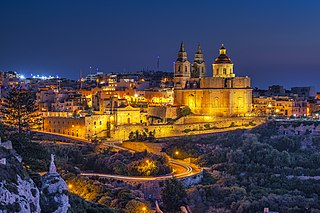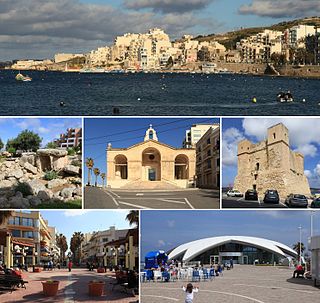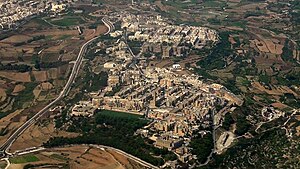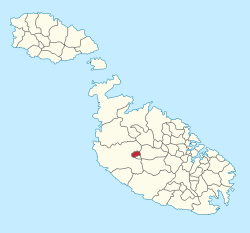
Mellieħa is a large village in the Northern Region of Malta. It has a population of 10,087 as of March 2014. Mellieħa is also a tourist resort, popular for its sandy beaches, natural environment, and Popeye Village nearby.

Floriana, also known by its title Borgo Vilhena, is a fortified town in the Port Region area of Malta, just outside the capital city Valletta. It has a population of 2,205 as of March 2014. Floriana is the birthplace of many famous Maltese, amongst which the composer of the national anthem, 'L-Innu Malti', Robert Samut; former Bishop of Malta Dun Mauro Caruana, the poets Oliver Friggieri and Maria Grech Ganado, the writer and politician Herbert Ganado and Swedish Idol winner Kevin Borg.

Rabat is a town in the Northern Region of Malta, with a population of 11,497 as of March 2014. It adjoins the ancient capital city of Mdina, and a north-western area formed part of the Roman city of Melite until its medieval retrenchment.

Saint Paul's Bay is a town located on the northeast coast of Malta in the Northern Region. It is a major residential and commercial area and a centre for shopping, bars, dining, and café life. As per the 2021 population census, it has also become the most populated town in the country.

San Ġwann is a town in the Northern Region of Malta, with a population of 14,244 as of 2021. Prior to its establishment as a distinct municipality, it was a fragmented community comprising parts of Birkirkara and St. Julian's. San Ġwann emerged as a new parish in 1965 and was officially recognised as a town in 1968. The Local Councils Act of 1993 identified San Gwann as a separate district with its own statutory local government authority, marking its transition from being part of the neighbouring localities. With the first San Gwann Council was elected on 16 April 1994.

Iklin is a village in the Central Region of Malta, with a population of 3,247 as at 2021. Iklin was established in the mid-20th century; however some archaeological sites and a medieval chapel, named as St. Michael Chapel, are proof to earlier settlements. Until recently, the town was considered to form part of the Three villages of Malta, as part of Lija. With the separation of Iklin from Lija, Iklin is no longer part of the three villages. It is bordered by Għargħur, San Ġwann, Birkirkara, Balzan and Naxxar.

Xemxija is a suburb in the western part of St. Paul's Bay in the Northern Region, Malta. It is a quiet resort, surrounded by the countryside and some of the most fertile valleys in Malta. There is also a picturesque small fishing harbour. The resort is the gateway to the sandy beaches of Golden Bay and to Mellieħa Bay. There are a number of hotels and restaurants in Xemxija.

Wignacourt Tower, also known as Saint Paul's Bay Tower, is a bastioned watchtower in St. Paul's Bay, Malta. It was the first of six Wignacourt towers to be built, and the first stone was laid on 10 February 1610. It replaced the role of Ta' Tabibu farmhouse which was previously known as Dejma Tower. An artillery battery was added a century later in 1715. Today the tower is a museum of fortifications around the Maltese Islands.
Konkors Kanzunetta Indipendenza is Maltese song competition held on a day near September 21. All songs are performed in the Maltese language and is one of the most anticipated events on the Maltese musical calendar. The event first took place back in 1983 in a span of four years until 1987 before returning just 10 years later in 1997 going on to take place each and every year since then. Several local stars like to submit their entries into such a prestigious musical event due to the fact that the songs are written in Maltese. In recent years there were a number of winners who went on to be successful both locally and abroad. Below you could find the list of the past winners.
L-Għanja tal-Poplu is a popular Maltese song competition first organized by Youth Travel Circle (YTC) on 5 May 1973 at the St. Albert College in Valletta. The founder of YTC is Rev. Maurice Mifsud. Initially the contest had to register as YTC members. From 1987 onward, the contest took a national dimension. The competing songs are sung primarily in Maltese and are written either by the singers themselves or other songwriters. In the 1990s the contest started being transmitted on local television stations. This contest is today organised by the voluntary organisation L-Għanja tal-Poplu and is also supported by Arts Council Malta.

Maltese architecture has its origins in prehistory, and some of the oldest free-standing structures on Earth – a series of megalithic temples – can be found on Malta. The islands were colonized by the Phoenicians and later the Romans, who established the cities of Melite and Gaulos. Although these were substantial settlements and are known to have had numerous temples, churches and palaces, few remains have survived apart from some architectural fragments.

Malta is for non-local government purposes divided into districts as opposed to the local government localities. The three main types of such districts – statistical, electoral at national level, and policing – have no mainstream administrative effect as the local councils form the first-tier – moreover only administrative tier – divisions of the country.
This page list topics related to Malta.
Mużika Mużika is the national song festival of Malta.

Local council elections were held in Malta and Gozo on 8 June 2024, in tandem with the European Parliament elections. This is the second time that all local councils of Malta shall be elected simultaneously in a single election, following the 2015 reform abolishing the previous system of half-council elections.

















